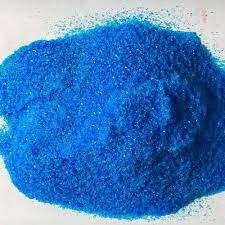
Copper(II) sulfate, commonly known as CuSO4, is a chemical compound that consists of copper, sulfur, and oxygen. It is an inorganic salt with a blue crystalline appearance and is widely used in various industries and applications.
Chemical Properties
Copper(II) sulfate has the chemical formula CuSO4 and is formed by the combination of one copper ion (Cu2+) and one sulfate ion (SO42-). The compound exists in several forms, including anhydrous (without water), hydrated, and pentahydrate.
The pentahydrate form, CuSO4·5H2O, is the most common and commercially available form of Copper(II) sulfate. It contains five water molecules for every molecule of the compound. This hydrated form appears as bright blue crystals or powder, and its color is often used to identify and distinguish it.
Physical Properties
Copper(II) sulfate has distinctive physical properties that make it easily identifiable. In its anhydrous form, it appears as a grayish-white powder, while the pentahydrate form exhibits a vibrant blue color. The pentahydrate crystals are monoclinic and can dissolve in water to form a blue-colored solution.
Copper(II) sulfate is soluble in water, and its solubility increases with higher temperatures. It has a molecular weight of 159.61 grams per mole and a density of approximately 3.6 grams per cubic centimeter.
Uses and Applications
Agriculture and Animal Husbandry: Copper(II) sulfate is commonly used in agriculture and animal husbandry. It acts as a fungicide and pesticide, controlling various fungal diseases in crops such as grapes, potatoes, and tomatoes. It is also used in animal feed to prevent copper deficiencies in livestock.
Electroplating and Metal Finishing: Due to its ability to conduct electricity, Copper(II) sulfate is used in electroplating processes. It serves as an electrolyte in copper electroplating, where a layer of copper is deposited onto a metal surface to enhance its appearance, durability, and corrosion resistance. The compound is also utilized in metal finishing applications to create an even surface for subsequent coatings.
Water Treatment: Copper(II) sulfate plays a crucial role in water treatment processes. It is added to swimming pools and spas to inhibit the growth of algae and bacteria. Additionally, in certain wastewater treatment systems, it is used to remove hydrogen sulfide gas and control odors.
Laboratory and Educational Applications: In laboratory settings, Copper(II) sulfate is utilized for various purposes. It is commonly used as a reagent for the detection of substances like proteins and reducing sugars. It can also be used as a coloring agent in certain chemical experiments. Moreover, Copper(II) sulfate finds its application in educational settings, where it is used to demonstrate chemical reactions and crystal formation.
Analytical Chemistry: Copper(II) sulfate is employed in analytical chemistry as a standard reagent. It is used in volumetric analysis, specifically in the determination of chlorine levels in water samples. The compound reacts with chloride ions, forming a precipitate that can be quantified to measure the chlorine concentration.
Copper(II) sulfate, commonly known as CuSO4, is a versatile chemical compound with various industrial applications. It is widely used in agriculture, mining, animal feed, and the chemical industry. Nigeria, with its abundant mineral resources, presents an excellent opportunity for entrepreneurs and investors to venture into copper(II) sulfate production.
This article aims to provide a comprehensive guide on how to start copper(II) sulfate production in Nigeria, covering key aspects such as raw material sourcing, production process, market potential, and regulatory considerations.
Before diving into the production process, it is crucial to understand the market potential of copper(II) sulfate in Nigeria. The compound finds application in various sectors, including agriculture, where it is used as a fungicide and pesticide. Additionally, it is utilized in electroplating, mining, animal feed additives, and the manufacturing of chemical intermediates.
Nigeria's agricultural sector, in particular, holds significant potential due to its large-scale farming practices and increasing demand for high-quality crops. Thus, starting copper(II) sulfate production in Nigeria can tap into both domestic and export markets, providing a favorable business opportunity.
Raw Material Sourcing
The primary raw materials required for copper(II) sulfate production are copper and sulfuric acid. Nigeria has substantial copper reserves, and the metal can be sourced from mining operations within the country. Copper ores, the primary source of copper, are found in various regions of Nigeria, including Zamfara, Nasarawa, and Kogi states. The ores are typically rich in copper, making them suitable for the production of copper(II) sulfate. Local mining operations can provide a consistent supply of copper ores, ensuring a steady production process.
Additionally, copper scrap and residues from copper wire manufacturing can also serve as viable sources of copper.
Sulfuric acid, the other essential raw material, can be procured from sulfur or sulfur dioxide, which are byproducts of the petroleum industry or produced through sulfur burning. Establishing partnerships with local mining companies or chemical suppliers is crucial for securing a steady supply of raw materials.
Production Process
The production of copper(II) sulfate involves several key steps:
Step 1: Copper Extraction - Copper can be extracted from copper ores or scrap through processes such as smelting, leaching, or electrowinning. The chosen method depends on the availability and quality of the raw materials.
Step 2: Copper Sulfate Synthesis - Once the copper is obtained, it is dissolved in dilute sulfuric acid to produce copper sulfate solution. This process involves controlling the temperature, concentration, and reaction time to achieve the desired product.
Step 3: Crystallization - The copper sulfate solution is then subjected to evaporation, allowing the compound to crystallize. Proper filtration and drying techniques are essential to obtain high-quality crystals.
Step 4: Packaging and Storage - The final step involves packaging the copper(II) sulfate crystals in appropriate containers, ensuring they are adequately labeled and stored in a dry environment to maintain their quality.
Infrastructure and Equipment
To start copper(II) sulfate production, you will need suitable infrastructure and equipment. The necessary infrastructure includes a production facility with sufficient space for raw material storage, production processes, and packaging. Adequate utilities such as water, electricity, and ventilation systems are crucial for smooth operations.
Key equipment required includes copper extraction equipment (such as smelters, leaching equipment, or electrowinning cells), storage tanks for raw materials, reactors for copper sulfate synthesis, evaporators for crystallization, filtration equipment, drying ovens, and packaging machinery. It is advisable to work with experienced engineers and process experts to design the production facility and select the appropriate equipment.
Regulatory Considerations
Before initiating copper(II) sulfate production, it is essential to comply with regulatory requirements and obtain the necessary licenses and permits. In Nigeria, regulatory bodies such as the National Environmental Standards and Regulations Enforcement Agency (NESREA) and the Standards Organization of Nigeria (SON) oversee environmental and quality standards, respectively. Engaging with these agencies early in the process can help ensure compliance with relevant regulations.
Marketing and Distribution
To succeed in the copper(II) sulfate market, a well-defined marketing and distribution strategy is crucial. Conduct market research to identify potential customers and their specific requirements. This may include agricultural companies, chemical manufacturers, mining operations, and animal feed producers.
Build a robust distribution network by establishing partnerships with distributors, wholesalers, and retailers. Additionally, leverage digital platforms and online marketplaces to reach a broader customer base. Participating in industry trade shows and conferences can also help create awareness and forge valuable business connections.
Quality Control and Environmental Considerations
Maintaining consistent quality standards is essential for the success of copper(II) sulfate production. Quality control measures should be implemented throughout the production process, from ore extraction to the final product. Additionally, it is crucial to adhere to environmental regulations and minimize the impact of mining and production activities on the environment. Implementing sustainable practices and ensuring responsible waste management are integral aspects of the copper(II) sulfate production industry.
Export Opportunities
Apart from meeting domestic demand, the production of copper(II) sulfate in Nigeria opens up opportunities for export. The global market for copper compounds, including copper(II) sulfate, is expanding due to its diverse applications. Engaging in international trade can boost the economy and attract foreign investments to the country. Establishing partnerships with international buyers and adhering to international quality standards will be crucial in capitalizing on export opportunities.
In conclusion, starting copper(II) sulfate production in Nigeria presents a lucrative business opportunity, given the compound's wide range of applications and the country's abundant mineral resources. By understanding the market potential, sourcing raw materials, establishing an efficient production process, complying with regulations, and implementing effective marketing strategies, entrepreneurs can embark on a successful venture in this sector.
With careful planning and execution, copper(II) sulfate production can contribute to Nigeria's economic growth while meeting the growing demand for this versatile chemical compound.






















